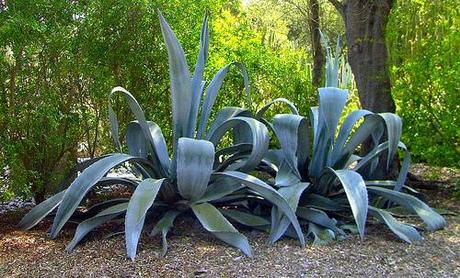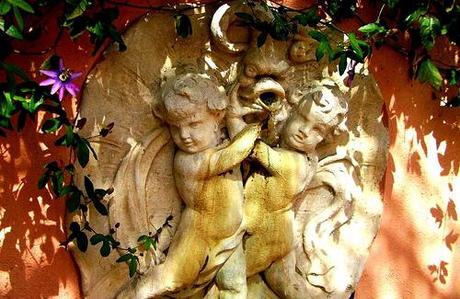
...softly sing in the dark'ning air
Though other lands of earth are fair
Forever and forever more
We will dream on the lotus shore
~ Mrs Gregory Smith, Atla: A story of the lost island, 1886.......
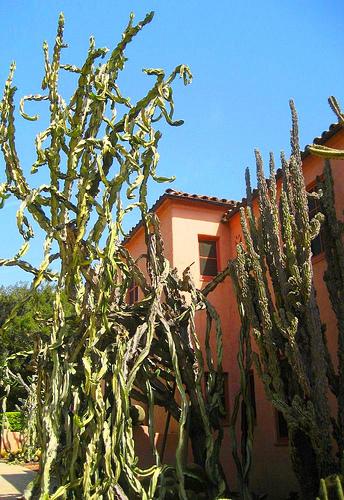
Lotusland.
Behind the elegant wrought iron gates and aged pink stucco wall, this classic Mediterranean villa wears a sunny tuscan hue. It reclines near the base of the chaparral-covered mountains in Montecito, California, and seems all the more vivid for the turquoise dome of sky that shines above it most days. Weeping euphorbia ingens, tall plants that grow in long, twisting loops, stand dramatically along the front of the house and form a fantastic and rag-tag assemblage.
This is an environment extraordinaire.
Exquisite. Edgy. Wild.
Vibrant life - 37 acres of it. The very air is tinged with a portent of discovery and drama, where mysteries are sure to be revealed, and more enticingly, secrets must surely be kept.
Within the wall, surrounding the house - are the legendary Lotusland gardens.
The story of Lotusland began in 1882, when Ralph Kinton Stevens, a transplanted Englishman, settled here.
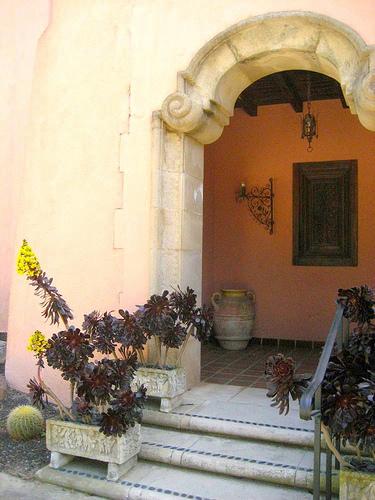
Stevens was enchanted by the arid, dry landscape of Montecito. He loved the plains, foothills, and mountains covered with chaparral. He admired the indiginous plants - the coastal live oaks, California sycamores, manzanita, ceanothus, sage, toyon, and grasses that proliferate along the southern coast of California.
Although he admired these natural surroundings, Stevens was not limited by what he saw - he was inspired by what it could become.
He was a natural plantsman, an avid horticulturist. He preserved many of the old-growth oaks and sycamores that continue to thrive on the property today. He also began filling the land with plants from around the world: palms, avocados, lemons, oranges, olives, bananas, mangos, and more.
Stevens called his estate "Tanglewood". He built his family home here, raised his children, and reveled in the life he had created.
He worked closely with other local plantsmen, and became something of a horticultural goodwill ambassador. He encouraged Southern Californians to create gardens using exotic varieties of plants that had never been seen in America before. Stevens furthered his mission when he opened a nursery at Tanglewood, providing local access to plant material that had been, only a few years before, unobtainable here.
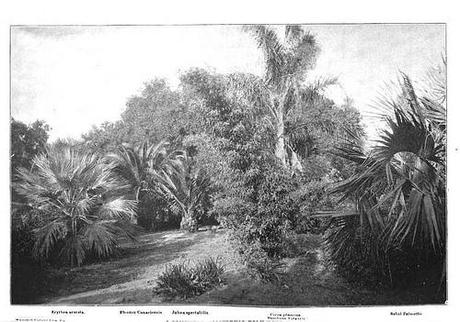
The frontispiece shows some of the finest specimens to be seen in the country. The slender growing, feathery-headed palm in the center is Cocos plumosa from Brazil; on the right corner stands the Sabal Palmetto from our Southern Atlantic coast; on the left, Palma Azul or Blue Palm, Krythea armata from lower California, while in the background are to be seen two huge specimens of the Palma de miel or Coquito Juba a spectabilis from Chile, and of Phoenix Canadensis from the Canary Islands , which has become so popular all over California. Under the Cocos is a young clump of giant bamboo, Bambusa vulgaris from India.
This picture was taken in El Montecito near Santa Barbara at the residence of the late Kinton Stevens who was one of the most enthusiastic pioneers to enrich California with plants from other lands ~Santa Barbara, Cal.
~ Dr F Franchesci, Out West Magazine, 1896
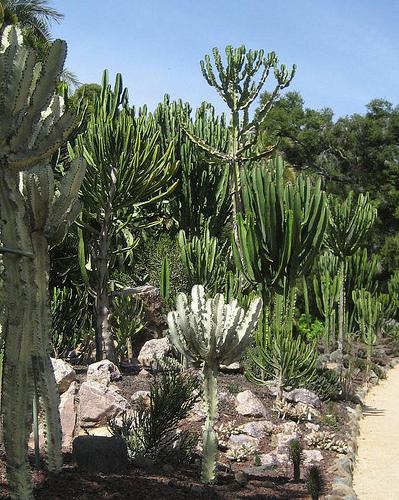
When Stevens' died, the estate languished. For years, it was rented out, then leased, until it was purchased by George Owen Knapp in 1913.
Knapp and his wife were generous philanthropists who loved theater, art, and travel. They roamed the world, but always loved to come home to Montecito, where they could relax, entertain, and share their home and beloved garden with family and friends.
In 1916, Palmer Gavit and his wife purchase the property, and named it "Cuesta Linda" - Beautiful Hill. They were inspired by the gardens and siting of the property. They commissioned Reginald Johnson, renowned architect, to design and build the home of their dreams - the very house that stands today. Construction was completed in 1920.
The Gavits hired George Washington Smith, another luminary architect, to design the signature pink wall, the pool and pavilion, garages, and other buildings scattered around the estate. The Gavit's dream coalesced with the help of Johnson and Smith.
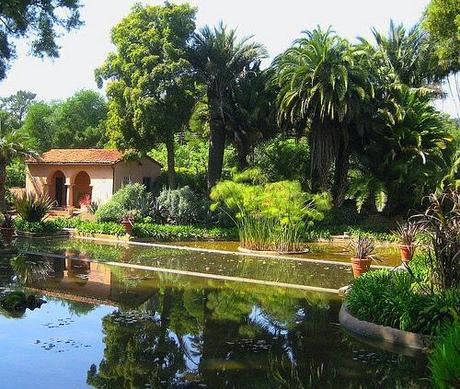
It had been more than 50 years since Ralph Kinton Stevens first purchased the property and began its transformation. By 1941, home and garden had grown into a singular and lovely creation.
And yet, the greatest transformation of all had yet to occur. In 1941, Madame Ganna Walska first appeared at the property on Sycamore Canyon Road.
Ganna Walska was born in Poland of relatively humble beginnings. As a very young woman, she set about to transmute herself into a world-class beauty who could beguile even the most worldly(and wealthy) of men. Her dramatic and sumptuous life played out on the world's stage. Her charm, allure, and powers of seduction were legendary. She insisted she be addressed as Madame Walska.
Madame Walska traveled extensively. She collected famous friends - especially handsome men. She took up opera. She wrote. She was feted by her admirers in every corner of the world. She was like a little tiny stick of dynamite - an petite but explosive package. Although society was scandalized by her outré behavior, the world was secretly delighted by her escapades and unconventional lifestyle.
She had numerous and well-publicized affairs - and a total of six marriages. Ganna Walska had voracious appetite for luxury and finery. She was bold, audacious, and she always cut a glamorous figure.
Madame Walska owned Théâtre des Champs-Élysées in Paris, along with dozens of bespoke costumes that Erte created for her to wear during her operatic performances. At home, her closets were filled with Lanvin, Patou, Ferragamo, Chanel, and Balenciaga designs. She had all manner of exotic feather and furs, gems and jewels.
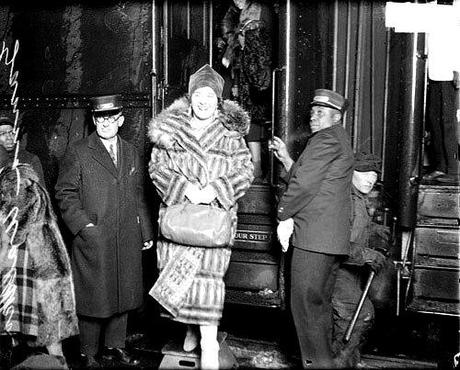
Her tastes - and appetites - were legendary.
When Ganna Walska and husband #6, Theos Bernard, found Cuesta Linda, they were thrilled. They purchased it and named the estate "Tibetland". Bernard, known for a time as “The White Lama”, was a yoga master and guru. Together, Walska and Bernard planned to create a spiritual retreat at Tibetland.
However - the guru was revealed to be a charlatan, and the marriage fell apart.
Now, it was just Ganna Walska and the Garden.
She named her estate, Lotusland, in 1945.
Madame's passions, formerly reserved for men, travel, luxury - were soon subsumed by her love of the garden. She cared less for fashion and frivolity these days - although she still dabbled.
She dug her hands into the black earth. She walked barefoot on the grass. She swam naked in the pool in the bright sun of the morning, and the soft coolness of moonlight.
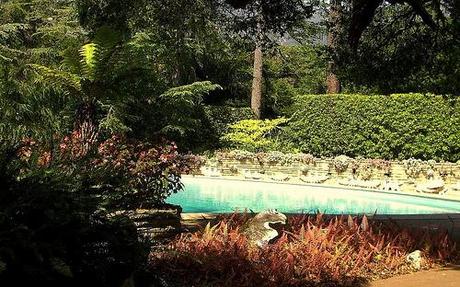
She imagined, designed - then installed - outrageous displays of plant material in the garden. She traded jewels for rare plants. She picked apples, apricots, lemons and clementines from the orchard. She woke early, and worked alongside her gardeners until late in the afternoons. She filled baskets with rose blooms she clipped from the garden.
She amassed a library filled with rare books about the historic gardens of the world, and more prosaic editions addressing architecture, landscaping, plant culture, and garden pests. She potted and pruned her geraniums, and had an aviary filled with birds. She built an outdoor theater, where she hosted musical performances and theatrical masques. Madame pulled weeds, spread manure, clipped hedges, pruned tree limbs. She became a gardener's gardener.
She engaged Lockwood de Forest, artist and landscape architect, to help implement her newest ideas. He designed the succulent garden, the cactus display in front of the house, and various other gardens on the property.
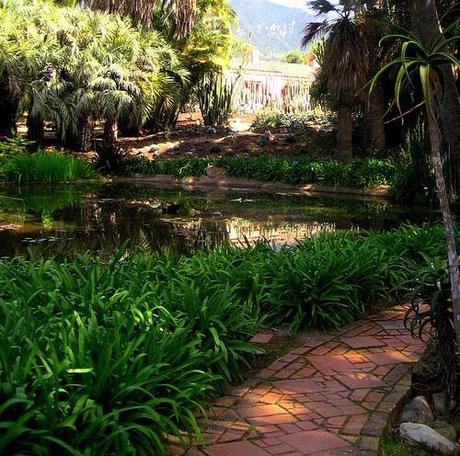
She engaged Ralph Tallant Stevens to join in planning her garden. Stevens, Ralph Kinton Stevens' son, had grown up on the land, and understood all the transformations and incarnations of the property. He was a founding member of the Santa Barbara Horticultural Society, and an important figure in the horticultural development of Santa Barbara County. He designed the iron gate that faces Sycamore Canyon Road, the Blue Garden. He helped to obtain and install the giant garden clock that has been restored as the centerpiece of the Topiary Garden.
Eventually, Joseph Knowles, a well-known local artist and teacher, worked with Madame in designing the Aloe Garden and the pool that is edged with a ring of abalone shells.
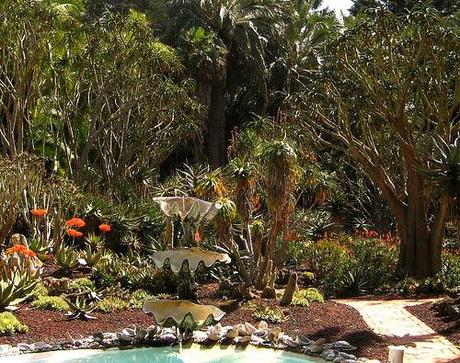
In the 1960s, Madame installed the Japanese Garden with the help of Frank Fuji, who recently retired from his 50-year tenure in the Garden. He worked at Lotusland until he was 90 years old.
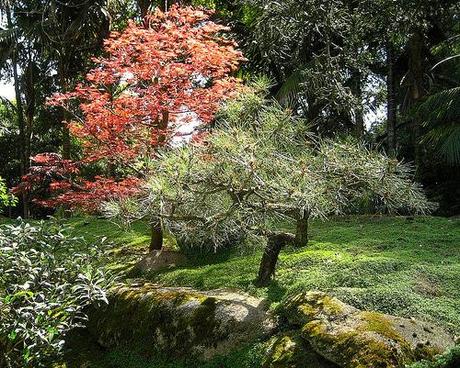
Madame Ganna Walska filled one of her three swimming pools with mud - and lotus plants. It was a bold move of genius. Every August, the shaded pool is transformed with statuesque lotus flowers that are held aloft on six-foot-tall stems. The nearby pools are covered with delicate waterlilies.
I think of her there, standing amid the rich, rosy colors that kaleidoscope in the dappled shade. I imagine her in the quiet summer heat that hums with life. Dragonflies (metallic cinnbar and bottle-green) flicker above still water. Liquid reflections of sky appear - a sharp china-blue. Flowers bloom. Birds dart into sheltering branches. A single leaf falls.
What did Madame think, in moments alone, about her true life's partner - the gardens of Lotusland? Although Madame's original vision of Tibetland as a spiritual retreat were not exactly realized, I assure you, this is the playground of the mystic and divine.
After Madame's passing in her 97th year, the dream continued. Her garden lived on as legacy. The Lotusland Foundation was formed. The Foundation restored the gardens and buildings that had been neglected in Madame's last years. Lotusland was opened as a public garden.
Lotusland docents, an intensively-trained and passionate lot, offer guided tours of the garden, twice daily, from February through November.
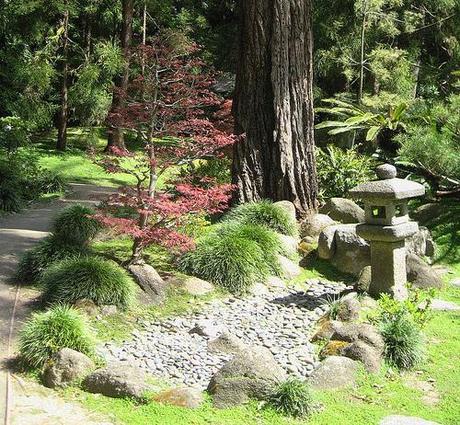
I worked for a season in the Garden Shop at Lotusland. I would arrive early in the morning to open the shop, and prepare for the 10am Saturday tour. Often, I was the first person in the garden, alone with squirrels and quail and rabbits in the fern and begonia gardens. Deeply shaded, the garden beds were flecked on either side with pink and peach-colored blossoms that nestled in the dark, textured leaves of prized begonias; the fragrant blooms from the huge angels' trumpet (datura) dripped with the remnants of last night's fog.
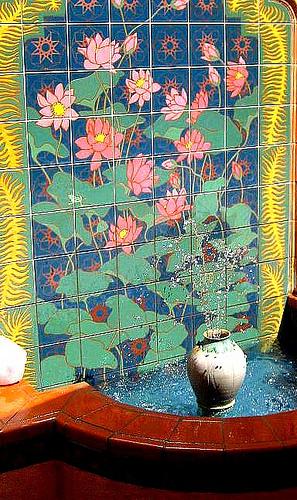
Walking through the Japanese garden, I would notice azeleas in bloom, or camellias, or the reddening Japanese maple leaves, each in its season. One morning, I saw a pair of blue herons in the pond, feasting on glittering red koi, while nearby, life-sized statues of cranes stood sentinal.
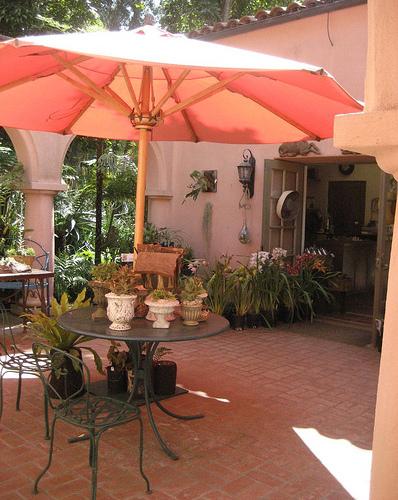
Between tours, I would sweep, and clean, and then sit on the patio and read the newest gardening books: The Gardens of Columbia, Seaside Gardening, The English Cottage Garden, Santa Barbara Style, The Trees of Santa Barbara, and many others.
In the late winter months, the paths were chilly, muddy and puddled in places, with rain dripping, like falling gems, down the columned cypress trees; in the heat of summer, I would linger in the cool tropical garden, where large philodenrons and bananas mingle beside the soft bark trails, and dozens of epiphyites hang above the pathways.
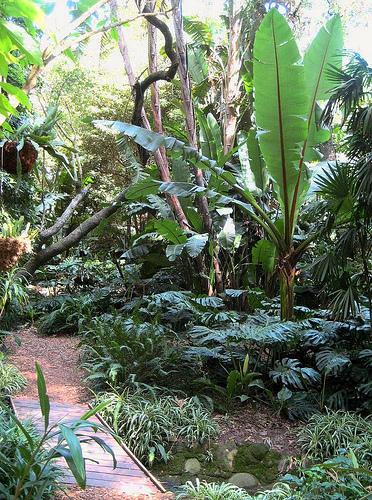
In the springtime that year, we all watched as a pair of tiny towhees nested in a potted plant on the patio. There, within the rim of the black one-gallon pot, beneath the leaves, they hatched their eggs. K was there when the babies had grown old enough to flutter, and hop up to the lip of the pot. They flapped and faltered amid great bird fanfare - and suddenly - they could fly. Just like that, they were gone.
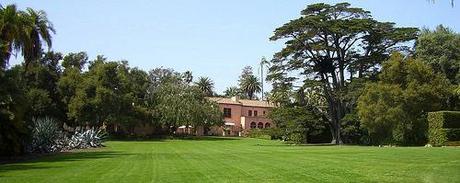
All around this magnificent estate, there are daily treasures, small and large. There are gardens galore to discover: the Blue Garden, the Cycad Garden, the bromeliads. The cactus garden was planted during my season at Lotusland. I thought the cacti out of place - too stark. And now, I see - it belongs. It is breathtaking and beautiful. The garden continues to evolve.
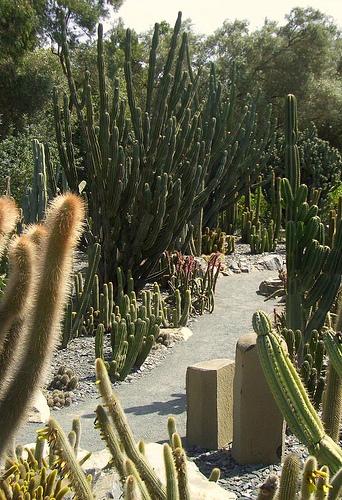
There is never a bad day to visit Lotusland. It is a living creature, a place of many faces and guises.
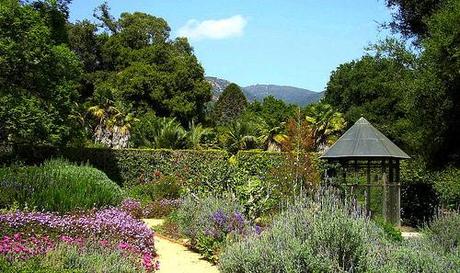
I was passing through the butterfly garden one afternoon, when a cloud of monarch butterflies drifted over the hedges and tumbled above the flowers as they flew along. I was mystified. From whence would a cloud of butterflies appear, and where could they be going? It seems almost anything is possible at Lotusland.
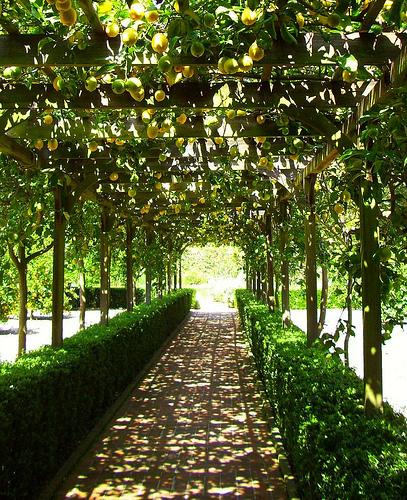
Lizards live here, and rabbits wild - and animals created from the plants themselves.
Lotusland is a shifting fata morgana of delight - illusion and actuality slip, shimmer, change places - and take on new shapes entirely - from moment to moment.
Visit the Lotusland website. It serves as your personal invitation.
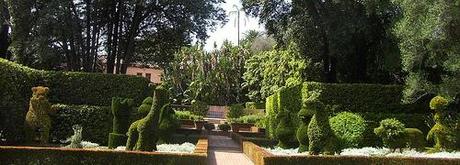
View the map, learn about upcoming events, make a reservation to take a real-life tour.
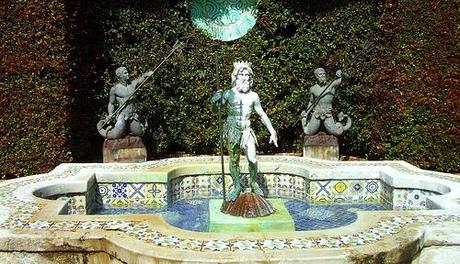
Lotusland was created - for all of us - by some of the world's most interesting and visionary gardeners. It is lovingly tended and maintained today, by an entirely new group of interesting and visionary gardeners, scholars, volunteers, and trustees who oversee the health and vibrant life of the garden.
It is a community resource, a teaching garden. It is a living legacy, a labor of love, a world-class historic and horticultural preserve.
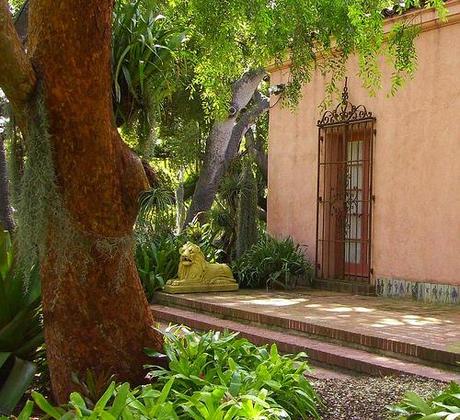
You must come and see it for yourself.
